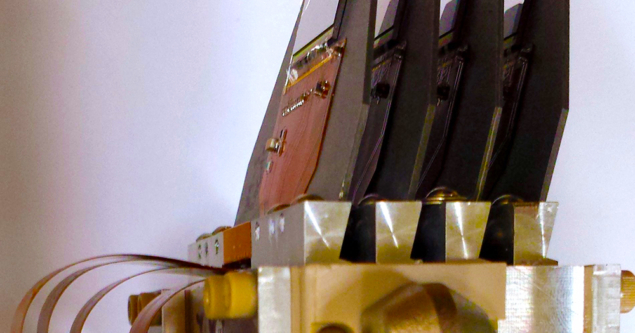A report from the ATLAS experiment

Protons accelerated by the LHC generate a large flux of quasi-real high-energy photons that can interact to produce particles at the electroweak scale. Using the LHC as a photon collider, the ATLAS collaboration announced a set of landmark results at the 40th International Conference on High Energy Physics last week, among which is the first observation of the photo-production of W-boson pairs.
As it proceeds via trilinear and quartic gauge-boson vertices involving two W bosons and either one or two photons, the production of a pair of W bosons from two photons (ɣɣ → WW) tests a longstanding prediction of the Standard Model (SM). This process is extremely rare but predicted precisely by electroweak theory, such that any observed deviation would suggest that new physics is at play. The measurement relies on the large 139 fb–1 dataset of proton–proton collisions recorded by ATLAS in LHC Run 2.

Protons usually remain intact or are excited into a higher energy state in photon collisions, with the products of any subsequent decay not reaching the innermost components of the ATLAS detector. In these cases, the electron and muon decaying from the W bosons – an event topology chosen to avoid the high background for same-flavour lepton pairs – are the only particles detected in the vicinity. However, if charged particles arise from nearby proton–proton collisions, the clean ɣɣ → WW signal can be missed. The main background is W-boson pairs produced in head-on proton–proton collisions where particles from the break-up of the protons are not detected due to imperfect detector coverage or reconstruction (figure 1). A total of 127 background events were predicted compared with 307 events observed in the data, corresponding to a signal excess of 8.4 standard deviations. This establishes the existence of light transforming into particles with weak-scale masses – a remarkable and previously unobserved phenomenon.
Innovation
Precisely testing SM predictions of photon collisions requires accurate knowledge of the rate protons remain intact relative to those that break apart. This is challenging to predict theoretically and probing these rates unambiguously requires directly detecting the intact protons. The ATLAS forward-proton spectrometer (AFP) is becoming increasingly indispensable for this task. Among the newest additions to the ATLAS experiment, and located a few millimetres from the beam 210 m either side of the collision point, the AFP can detect protons that have been scattered in photon–photon collisions but which have nevertheless been focused by the LHC’s magnets. Its pioneering results so far analyse a standard-candle process where a proton is scattered in photon collisions that produce electron or muon pairs (ɣɣ → ℓℓ). For these signals, the measured proton energy loss is equal to that predicted from the lepton pairs measured in the main ATLAS detector (figure 2). ATLAS reported 180 events with a proton having matched kinematics to the lepton pair with an expected background of about 20 events. This corresponds to a significance exceeding nine standard deviations for both lepton flavours, establishing the presence of the signal and the successful operation of the AFP spectrometer in high-luminosity data. The detectors were sufficiently well understood to measure the cross sections of these processes.

Observing ɣɣ → WW and scattered protons in ɣɣ → ℓℓ interactions are long-awaited milestones in an emerging experimental programme studying photon collisions. These complement recent heavy-ion results where ATLAS measured muon pairs from photon collisions and the kinematic properties of light-by-light scattering – a very rare process predicted by quantum electrodynamics. Interestingly, the latter was also used to search for the axion-like particles predicted by certain extensions of the SM.
Observing ɣɣ → WW and scattered protons in ɣɣ → ℓℓ interactions are long-awaited milestones
The techniques developed to study ɣɣ → WW and ɣɣ → ℓℓ interactions lay the groundwork for future, more detailed tests of the SM. Further results using the AFP spectrometer can improve theoretical understanding of photon collisions that will also benefit future measurements of ɣɣ → WW production. These landmark experimental feats will only become more interesting with the increased dataset of Run 3 and the high-luminosity LHC.
Further reading
ATLAS Collaboration 2020 ATLAS-CONF-2020-038
ATLAS Collaboration 2020 ATLAS-CONF-2020-041
ATLAS Collaboration 2020 CERN-EP-2020-135
ATLAS Collaboration 2020 CERN-EP-2020-138








